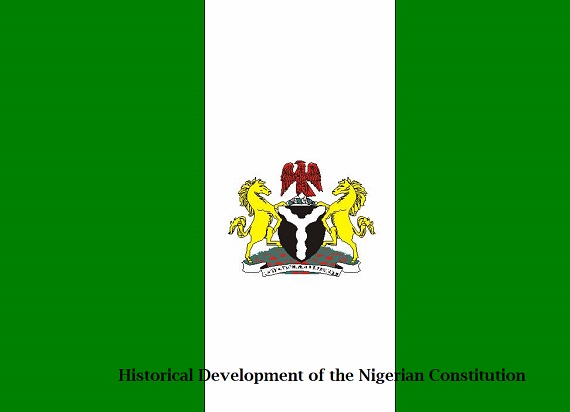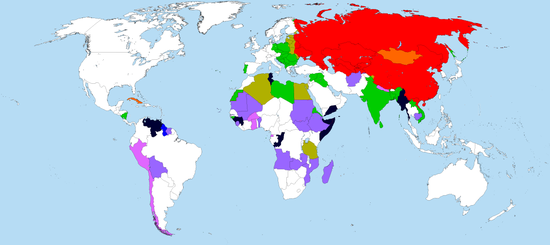Historical Development of the Nigerian Constitution
The history of Nigeria is actually quite interesting, especially when it comes to the question about constitutional development in Nigeria before Independence. Let’s look through some facts you have never heard before!

When did constitution making start in Nigeria?
1st October 1963
This new constitution was passed into law on 1st October 1963 and it was in accordance with the constitutional conference that was held in Lagos between July 25 and 26, 1963. It was this constitution that made provision for real independence in Nigeria.
What are the origins of the Constitution?
The Constitution was written during the summer of 1787 in Philadelphia, Pennsylvania, by 55 delegates to a Constitutional Convention that was called ostensibly to amend the Articles of Confederation (1781–89), the country’s first written constitution.
What was Nigeria called before?
The Benin Empire (1440–1897; called Bini by locals) was a pre-colonial African state in what is now modern Nigeria. It should not be confused with the modern-day country called Benin, formerly called Dahomey.
Who introduced the first constitution in Nigeria?
Nigeria’s first constitution as a sovereign state was enacted by a British order in council so as to come into force immediately upon independence, on 1 October 1960. Under this constitution Nigeria retained Queen Elizabeth II as titular head of state.
Who named Nigeria?
journalist Flora Shaw
The name Nigeria was taken from the Niger River running through the country. This name was coined in the late 19th century by British journalist Flora Shaw, who later married Lord Lugard, a British colonial administrator.
Who is father of Nigeria?
Olayinka Herbert Samuel Heelas Badmus Macaulay (14 November 1864 – 7 May 1946) was a Nigerian nationalist, politician, surveyor, engineer, architect, journalist, and musician and is considered by many Nigerians as the founder of Nigerian nationalism.
INTRODUCTION:
The importance of a constitution in any given society cannot be overemphasized. The constitution, in Nigeria’s situation, is the supreme law of the land which all acts of individuals and of parliament must not contravene. It is the fundamental and organic law of a nation or state that establishes the institutions and apparatus of government, defines the scope of governmental sovereign powers, and guarantees individual civil rights and civil liberties.
It is trite that one of the sources of a constitution is other constitutions. This is the major concern of this present work. The aim of this work is to trace the history of Nigeria’s constitution from the 1922 constitution to the 1979 constitution. This will help us to understand better, how previous constitutions have been fashioned for Nigeria and will go a great length in making us understand the source of our present constitution from the looking glass of constitutional history.
The Purpose Of This Write Up
The purpose of this write up is to trace the source of the Nigerian constitution and how it was developed from time. The development actually stated from 1922 and a substantial content was added in 1979; that was long after the Nigerian Civil War. Yet more content was added in 1999 when a number of amendments were also made that year. The 1999 constitution is the exact document being used by the Nigeria of today. However, many think there is need to also modify this constitution.
Lagos was never part of the Nigerian entity at the initial stage. It was not annexed to Nigeria until 1861. The man that formulated the first constitution for Nigeria was Sir Hugh Clifford. He was pressured to do this by the Caseley Hayford-led West African congress in 1922, which was the year the first constitution was constituted for Nigeria and a host of other West African countries colonized by the British, namely Gambia, Sierra Leone and Gold Coast.
The Clifford Constitution of 1922 introduced the very first electoral system in Nigeria and the very first election was conducted that year into the Nigerian legislative council; Calabar was given 1 slot and Lagos was given 3 slots. Only those earning 100 pounds per annum were allowed to contest in the election.
According to the history of Nigeria, there were four constitutional periods before the Independence. Here is a list:
1) The Clifford Constitution of 1922;
2) The Richard’s Constitution of 1946;
3) The Macpherson Constitution of 1951;
4) The Lyttleton Constitution of 1954.
The Richard constitution
It came up in 1944 under the leadership of the then governor Sir Arthur Richards and it forms the very first constitution amendment in Nigeria. The Nigerian educated elite formed the chunk of those that pressured him to institute the constitution amendment. The purpose of this constitution all amendment was to
- Promote the unity of Nigeria
- Provide adequately for every entity that makes up the Nigerian nation in the constitution.
- Make more provision for Nigerians to determine their own affairs.
A new legislative council was provided for in the new constitution. The constitution amendment team comprises the governor, 16 official and 28 unofficial members. The governor nominated 2 and the 4 were elected out of the 28 unofficial members. 11 members were nominated by the north, 8 by the east and 6 by the East. The said constitution made provision for regional houses of assembly. The native authorities were to nominated members of the regional assembly. For anyone to qualify for election, the member should earn at least 50 pounds per year, which made it possible for more people to participate in elections.
The first set of Nigerians to be members of Lagos executive council were Sir Adeyemo Alakija and Bankole Rhodes.
The Macpherson constitution
Nigerians were included in this constitution amendment that took place under the leadership of the then governor Sir John Macpherson. Many Nigerians were consulted, even those residing in villages. The Ibadan Conference of 1950 formed the basis for the southwest’s viewpoint to the new constitution. The federal house of representative was provided for in the new constitution with 136 elected members, 6 ex-officio members and 6 other members nominated by the governor. The north had 68 members, the west had 34 members and same number came from the east.
The Lyttleton Constitution
The need for this constitution began with a proposal made by Anthony Enahoro of the Action Group that Nigeria should be given independence in 1956. The northerners felt they were not ready for independence and they opposed it. This led to the Lyttleton constitution and it was held in London in 1954. The outcome of the conference formed the basis for the Lyttleton Constitution. The constitution abolished the West African court of appeal; it however established the Nigerian Supreme Court and a number of regional high courts. The constitution made provision for the regions to govern themselves and the western and eastern regions stated self-governance in 1957. Two years later, the north began self –governance. Southern Cameroon however opted out of Nigeria via a referendum.
The Independence Constitution
Nigeria finally became an independent nation on October 1st, 1960. As at independence, the Queen of England was still the head of state of Nigeria. She was represented by Dr. Nnamdi Azikiwe, the Nigerian Governor-General, while Tafawa Balewa became the Prime Minister. The purpose of the constitution was to completely remove foreign influence on the Nigerian state. It took its basis from the 1954 constitution, but a number of changes were made. Provision for citizenship acquisition was made in the new constitution. Provision for constitution amendment was also made in it. Nomination formed the basis for appointing judges for the courts. The highest court of appeal in Nigeria according to this constitution was the Privy Council.<
In the new constitution provision was made for dual executive, comprising the head of state and head of government. The head of state was a ceremonial personality, while the head of government had executive power.
The 1963 Republican Constitution
This new constitution was passed into law on 1st October 1963 and it was in line with the constitutional conference that was held in Lagos between July 25 and 26, 1963. The constitution made provision for real independence of the Nigerian state. This constitution removed Queen Elizabeth as the head of state. The constitution provided that the president be chosen by secret ballot by members of the national assembly and House of Representatives. This brought in Dr. Nnamdi Azikiwe as the president and commander in chief of the armed forces.
The constitution also recognized the Supreme Court as the highest court of appeal in Nigeria. The said constitution abolished the judicial serve commission. The prime minister became the one appointing the judges. The senate membership was increased to 56 from 44. The house of representative was increased to 312 from 305. This was necessitated by the creation of the Mid-western state.
The presidential constitution of 1979 and 1999
This was instituted by General Olusegun Obasanjo, who constituted a 49 member constitution drafting committee and it was headed by F.R.A Williams. The constitution was amended by Justice Udo Udoma and it as instituted on October 1st, 1979. Parliamentary system of government was jettisoned by the constitution and it was replaced with the presidential system of government. It made the president both the head of state and head of government. The constitution also determined that electorates should choose the president. The senate membership was increased to 95 and the House of Representatives’ membership was increased to 450.
Conclusion
The West African Court of Appeal was eliminated. There was a Supreme Court for the whole country and separate High Courts of Justice for every region. Nevertheless, the Highest Court of Appeal was the judiciary committee of the privy council. By the way, the Eastern and Western parts became independent in 1957, whereas the Northern part became independent in 1959. As for the Southern Cameroon, it should be mentioned that it opted out of Nigeria because of the referendum.
So, as you can see the constitutional development in Nigeria is rather interesting. Step-by-step the leaders tried to improve it as much as possible. In any way, this article is about constitutional development before independence. So, check out the second part of our story! Good luck!
We Believe This Article Was Helpful, Don’t Hesitate To Share This Information With Your Friends On Facebook, Twitter, Whatsapp and Google plus.
Copyright Warning: Contents on this website may not be republished, reproduced, redistributed either in whole or in part without due permission or acknowledgement. All contents are protected by DMCA.
The content on this site is posted with good intentions. If you own this content & believe your copyright was violated or infringed, make sure you contact us via This Means to file a complaint & actions will be taken immediately.




Your write up is really helpful. Keep up the good work, would love to read more of your works.
Thank you.